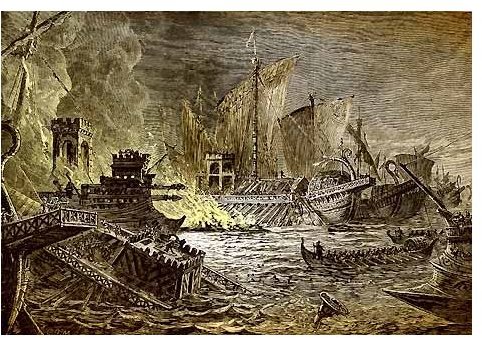Interactive History Curriculum: High School Interactive Assignments From The Julio-Claudian Dynasty to The Five Good Emperors & More
An interactive curriculum engages students in the learning process. That’s a nice sounding definition, but what does it really mean? While the word interactive invokes images of “clickable” sites with dynamic time-line images or hands-on activities like building a model of the Parthenon, an Interactive History Curriculum can include less technological activities such as role-playing or treasure hunts. Interactivity stimulates the mind to assimilate, analyze, and question the subject at hand. Questions should be presented to students and ideally, developed by the students as they work.
An Interactive history curriculum is not designed to throw students into the unknown to learn completely on their own. A well developed interactive lesson plan will include a presentation of new material blended with interactive activities that get students involved with the new content. Make students aware of how their work will be assessed by making expectations clear in the beginning of each activity. Handing out rubrics with a breakdown of what is expected and how they will be graded is a good idea. This will set the stage and allow students to use their time wisely.
This article contains examples of activities and assignments from an interactive history curriculum on The Roman Empire. The activities included are not the only types that can be used but they should give teachers an idea of how to design an interactive curriculum for their own classrooms.
Focus: Roman Empire, Augustus to the Fall
Grade Level: 9-12
Interactive Unit Outline:
Introduction:
- Review the history of Ancient Rome from Republic to Empire
- The rise of Augustus, (Octavian, Julius Caesar’s nephew)
- Changes to Law, Government, and Economy
Interactive Assignments:
1. The Ides of March, March 15, 44 BC: Have students investigate what the saying means and where it came from using these online resources:
-
_Famous Quotes from Julius Caesar:
_https://www.brighthubeducation.com/homework-help-literature/34234-important-quotes-from-julius-caesar/ -
Interactive Calendar -https://www.encyclo.co.uk/calendar/March.php
2. Research the Second Triumvirate (Octavian ,Marc Antony and Marcus Lepidus) and its dissolution:
-
An interactive map that shows how the empire was divided under the Second Triumvirate. - https://explorethemed.com/DemiseRep.asp?c=1
-
Who was Marc Antony? This lesson plan contains an interactive assignment in which students create a fictitious journal entry or letter written in the point-of-view of a significant historical figure. Dates and facts must be accurate and presented it in an inventive way (i.e. skit, power-point slide show, a Guess Who? reading of their letter or journal entry).
3. Battle of Actium: The key players and its significance. Information and an interactive map of the battle can be found here:
https://explorethemed.com/DemiseRep.asp?c=1
https://www.history.com/topics/battle-of-actium
4. Reign of Augustus (27 BC – 14AD): Examine changes to Roman Law, Government and Army.
Background Information: https://www.roman-empire.net/emperors/augustus.html
See the recently unearthed House of Augustus which opened to visits in 2008.
5. Julio-Claudian Emperors (https://www.roman-emperors.org)
Tiberius-adopted son of Augustus
Caligula-killed by palace guard 41 AD
Claudius –uncle to Caligula
Nero-Claudius’s stepson became emperor in 54 AD
6. The Good Emperors (https://www.roman-emperors.org)
Nerva
Trajan
Hadrian: Reinforced Rome’s frontiers and Defenses. See https://www.hadrians.com/
Antonius Pius
Marcus Aurelius: The philosopher-emperor
Give students this table to fill in while researching the Roman Emperors.
7. Pax Romana (31 BC – 180 AD): Have students investigate the advancement of architecture, Roman Mythology, and the Rise of Christinity.
Find interactive maps and quizzes at https://resourcesforhistory.com
A Brief History of Roman Architecture -https://www.brighthub.com/engineering/civil/articles/52172.aspx
8. Decline of the Roman Empire
An Interactive Quiz : https://explorethemed.com/quiz.asp?quizId=8
Interactive website activities on the Roman Empire
The following resources are appropriate for any topic in the Interactive History Curriculum on the Roman Empire.
- Try this interactive map that allows the user to explore the fifty-three provinces of the Roman Empire:
https://www.ancientworlds.net/aworlds_media/ibase_1/Special/Maps/worldRegions_11.swf
- The game of S.P.Q.R. (SANATUS POPULUSQUE ROMANUS (The Senate and People of Rome))
Set in 205 AD. It is the player’s job to find four journals of key character and thwart the plans of Calamitus, a barbarian who plans to bring down the city of Rome. https://www.ancientworlds.net/aw/SPQR/GamePage
Resources
https://www.encyclo.co.uk/calendar/March.php
https://resourcesforhistory.com
https://news.bbc.co.uk/2/hi/7286305.stm
https://www.brighthub.com/engineering/civil/articles/52172.aspx
Image from: https://www.culturalresources.com/images/Actium.jpg
This post is part of the series: World History in a Year (or 10 months) Part 3
A series of lesson plans for a world history curriculum. This series is a continuation of two other collections of world history lesson plans.
